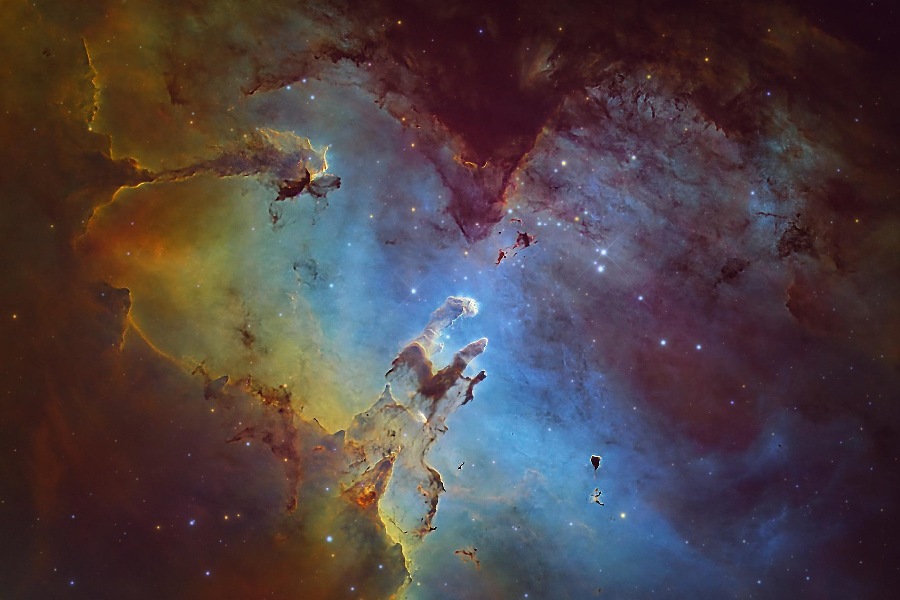The Eagle Nebula is a captivating celestial object that has captured the imagination of astronomers and stargazers alike for centuries. Its intricate and dynamic features stand as a testament to the awe-inspiring beauty and complexity of the universe beyond our planet. But what is Eagle Nebula?
In this article, we embark on a journey to explore the enigmatic Eagle Nebula, a celestial marvel nestled within the constellation Serpens. Our exploration will delve into the fascinating story of its discovery, unravel its distinctive characteristics, unveil the origins behind its name, and the intricate processes governing its formation.
Join us as we uncover the mysteries and marvels of this iconic nebula, offering a glimpse into the profound complexities that shape our cosmic landscape.

What Is Eagle Nebula?
The Eagle Nebula, also called Messier 16 (M16) or NGC 6611, is found in the Serpens constellation. It’s renowned for its stunning “Pillars of Creation”, large columns of gas and dust where new stars are being born.
This nebula is about 7,000 light-years away from us and measures approximately 70 by 55 light-years in size. It serves as a breeding ground for stars, actively creating new ones from the surrounding interstellar material. The Eagle Nebula became famous thanks to a memorable image captured by the Hubble Space Telescope in 1995.
Discovery of the Eagle Nebula
The Eagle Nebula’s discovery didn’t happen all at once but unfolded gradually over time. In 1745, Swiss astronomer Jean-Philippe Loys de Chéseaux noticed a faint glow in the Serpens constellation. This was the first time the Eagle Nebula caught anyone’s attention, but its true beauty remained hidden for over 200 years.
Things changed dramatically in 1995 when the Hubble Space Telescope captured an image of the “Pillars of Creation” within the nebula. These towering columns, shaped by young stars, mesmerized people around the world. This image sparked immense curiosity and prompted a wave of new research into the secrets of the nebula.
Advancements in technology have been key to unlocking the mysteries of the Eagle Nebula. With powerful telescopes and advanced imaging tools, astronomers can now delve deeper and see the nebula with unprecedented clarity.
These observations have revealed intricate structures and complex processes within the nebula. What was once a chance discovery has become a focal point of astronomical research, thanks to its breathtaking beauty and the profound insights it offers into the birth of stars.
Naming of the nebula
What Is Eagle Nebula name’s origin? The “Eagle Nebula” moniker arose from the cosmic cloud’s distinctive appearance. It resembles an eagle in flight from certain viewing angles.
Originally cataloged as Messier 16, the descriptive “Eagle” name caught on. It reflects the historical practice of naming cosmic objects after familiar shapes to aid identification. The powerful, soaring eagle imagery symbolizes strength, freedom, and vision, qualities fitting for this majestic nebula.
Additionally, some Native American traditions view the eagle as sacred, connecting it with celestial realms and spiritual guidance. This adds cultural resonance to the symbolism. Overall, the name captures the nebula’s awe-inspiring grandeur and majesty, igniting the imagination of observers.
Physical Characteristics of the Eagle Nebula
The Eagle Nebula is a colossal molecular cloud spanning roughly 70 light-years across. Composed primarily of hydrogen gas and dust particles, it’s most famous for the towering “Pillars of Creation.”
As mentioned, these dramatic structures are columns of gas and dust sculpted by fierce winds from young stars, reaching heights of four to seven light-years. But what type of nebula is the eagle nebula?
Classified as an emission nebula, the Eagle Nebula glows red and pink. This luminescence comes from excited hydrogen gas, energized by the intense radiation from nearby stars. Scattered starlight also paints dusty regions in hues of blue and green, creating a breathtaking tapestry of color.
Within the Eagle Nebula lie dense stellar nurseries, where gravity pulls on gas and dust, triggering the birth of new stars. These infant stars, called protostars, are still shrouded in their gaseous cocoons. Meanwhile, massive, hot stars already blaze within the nebula, sculpting its form with powerful winds and radiation.
Star Formation in the Eagle Nebula
The Eagle Nebula is a busy, stellar nursery. Dense pockets within its giant gas clouds collapse under gravity, forming the cores of future stars. These infant stars, called protostars, grow and evolve, shaping their surroundings.
The nebula is an ideal place for new stars to form because it has plenty of hydrogen gas and dust, essential for creating stars. The strong radiation and winds from large stars in the nebula compress nearby gas clouds, which helps to kickstart the formation of more stars.
As the new stars begin to grow, they are protected by dusty cocoons from the harsh external forces. Within the Pillars of Creation, astronomers have observed both newborn stars and protostars in the development process.
Inside the nebula, there’s a young star cluster called NGC 6611, which contains hundreds of hot stars. Surveys have also uncovered numerous other groups of stars throughout the Eagle Nebula, indicating that star formation is actively happening in this region.
Conclusion
What is Eagle Nebula? It stands as a testament to the profound beauty and complexity of the universe. From its captivating “Pillars of Creation” to its role as a bustling stellar nursery, this celestial marvel continues to inspire wonder and awe among astronomers and stargazers alike.
Through technological advancements and centuries of observation, we have unveiled the intricate processes shaping this nebula. This has offered insights into the fundamental mechanisms governing the cosmos.
As scientists continue to explore and study the Eagle Nebula, they embark on a journey to unravel its mysteries. This journey further deepens our understanding of the vast and wondrous universe in which we reside.
